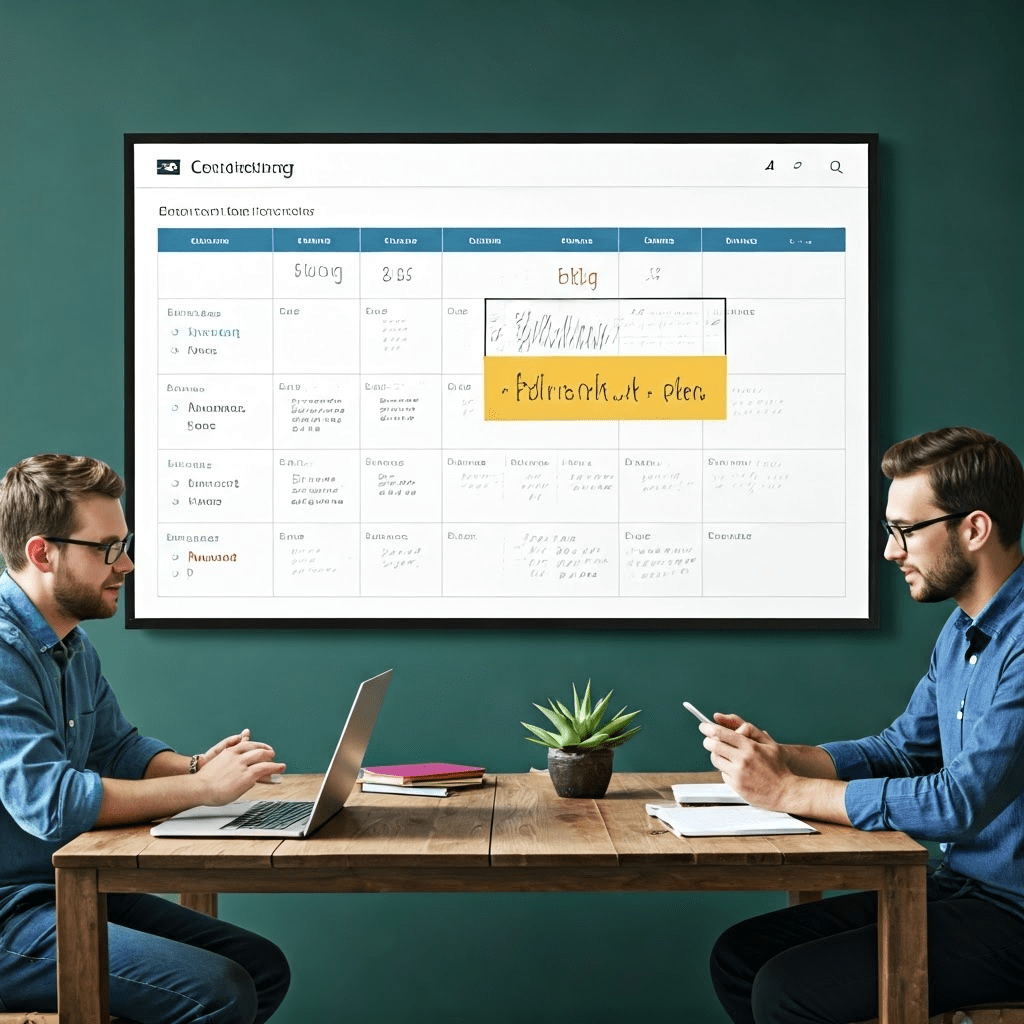Key Highlights
- Content marketing plays a critical role in today’s digital marketing landscape, helping businesses connect with their target audiences organically.
- From identifying your target audience to crafting engaging blog posts, this guide offers a comprehensive overview of content marketing fundamentals.
- Discover the significance of SEO, social media promotion, and multimedia elements in maximizing your blog’s reach and impact.
- Explore advanced blogging techniques such as guest blogging, collaborations, and email marketing to further enhance your content marketing efforts.
- Stay ahead of the curve by understanding emerging trends in content marketing and adapting your strategies to the ever-evolving digital landscape.
Introduction

In today’s digital marketing world, creating a successful content strategy that includes different forms of content marketing is very important. It helps build brand awareness and connect with your audience. This guide will give you key knowledge and clear strategies for using blogging and content marketing effectively. If you are a business owner, a marketing expert, or someone who wants to start a blog, you will find useful tips here to improve your content marketing skills.
Understanding Content Marketing and Blogging
Content marketing is about making and sharing useful content that matters to your audience throughout the customer journey. This helps you draw in and keep a specific group of people. When you share helpful information that connects with your target market, you can build trust and credibility over time.
Blogging is a key part of content marketing. It gives you a space to share ideas, tell stories, and connect with your audience more deeply. With interesting blog posts, you can teach, entertain, and inspire your readers. This builds strong connections that can turn into brand loyalty and more sales.
The Evolution of Digital Content
The world of digital marketing has changed a lot in how we consume content. Static web pages with little information are no longer popular. Nowadays, people want different and engaging types of content that fit their changing likes.
Industry trends show a big rise in video content, interactive infographics, and personalized experiences. As technology gets better, digital marketers need to adjust to these new ways people consume content. This will help them stay important and grab the attention of their target audiences.
You should mix up your content portfolio. Use short-form videos made for social media and long-form blog posts that give deep analysis. This helps to create a better and more exciting experience for your audience.
Why Blogging Is a Keystone in Content Marketing
Blogging is a key part of a good blog content strategy and content marketing strategy. It fits well with your business goals. When you regularly create quality blog content, you build a space to connect with your target audience. This helps drive traffic to your website and can lead to more leads and sales.
A company blog is a central place for all your content marketing efforts. It lets you show your skills, share helpful insights, and attract organic traffic using smart SEO practices to rank higher in organic search results. Whether you want to boost brand awareness, generate leads, or show your expertise, blogging is a great way to get real results.
By providing valuable content that fits what your audience cares about, you can grow a loyal following. This group will want to read your content, interact with your brand, and eventually become paying customers.
Setting the Stage for Successful Blogging

Before you start your blogging journey, it is important to build a strong base for success. First, understand your clearly defined audience. Then, define clear and measurable marketing goals. When you match your content with what your ideal readers want, you boost engagement and get better results.
Successful blogging is more than just putting out content. It involves creating a plan that helps reach your overall business goals.
Identifying Your Target Audience
Identifying your target audience is important for creating marketing strategies that connect. When you know their demographics, interests, problems, and dreams, you can adjust your blog content to fit what they need and like.
Begin by making detailed buyer personas. These are fictional pictures of your best customers. Think about their age, where they live, what jobs they have, what they enjoy, and what challenges they face. Knowing your target audience well helps you create content that meets their needs. This can lead to more engagement and conversions.
When you understand your target audience, you can change your writing style, pick topics that matter, and share your content through the best chanblogging and content marketing channels. This way, you can reach and impact more potential customers.
Establishing Clear Marketing Goals
Setting clear marketing goals is very important. It helps you measure how well your efforts are working. It also makes sure your content marketing fits your business goals. Without clear goals, it’s easy to forget what you want to achieve.
Think about what you want from your blog. Do you want to increase brand awareness? Or generate leads, bring more visitors to your website, or show that you’re a leader in your field? Once you know your main goals, break them down into SMART goals. That means they should be specific, measurable, attainable, relevant, and time-bound.
By having clear marketing goals, you create a guide for your content creation. This ensures that each blog post helps your overall business success and supports a successful content marketing strategy.
Preparing for Your Blogging Journey

Preparing for your blogging journey is very important for long-term success. You should have the right tools, resources, and knowledge. This will help you create content more easily and make your blog better.
Doing good market research is key. It helps you understand your niche and find content gaps. This way, you can write blog posts that connect with your target audience. By looking at industry trends and studying your competition, you can set your blog up for success.
Essential Tools and Resources for Every Blogger
Content creation uses different tools and resources. They help make your work easier and improve its quality. For example, Grammarly checks your blog content for grammar issues. Canva helps you create great-looking graphics.
An editorial calendar is important for organizing your blog content. It helps you schedule posts and stay consistent. This calendar gives you a clear view of your content plan. You can plan ahead, manage deadlines, and make sure you publish long form blog posts regularly.
Using these tools lets you focus on what is most important. That is creating quality content. This content engages your audience and helps you reach your content marketing goals.
How to Conduct Market Research for Content Creation
Market research helps you understand your audience better. It shapes your content strategy and ensures you create material that they will like. By knowing the latest industry trends, looking at what your competitors do, and finding areas where content is missing, you can help your blog succeed.
Here’s how to do good market research for your blog:
- Identify Industry Trends: Keep up with the latest news and changes in your industry.
- Analyze Competitors: Look at what competitors share on their blogs and social media. See their strong and weak points, and find ways to do better.
- Engage in Social Listening: Track important keywords and hashtags online. This can reveal what your audience cares about, what problems they face, and what they prefer.
By using market research, you can create content that matches what your audience wants. Filling gaps in content and making your blog a helpful place can attract more readers. Also, original research and data can give you new ideas and build leadership in your field.
Crafting Your Content Marketing Strategy
A clear content marketing strategy helps guide your blogging activities. It makes sure your content matches what your target audience likes and needs. This also supports your business goals. Every piece of content you create should reflect your brand’s voice and personality. This builds a strong and memorable connection with your audience.
Finding themes and topics that connect with your audience keeps your blog relevant and engaging. This will help increase traffic, leads, and conversions.
Defining Your Brand Voice and Personality
Defining your brand’s voice and personality is very important. It helps create the same experience for your audience. This is not just about your logo and visuals. It also includes the tone, language, and feelings in your content.
Think about your brand’s values, mission, and target audience. Do you want a professional and helpful tone? Or a more casual and friendly style? A clear brand voice builds brand awareness. It helps your readers feel familiar and trust you more.
When you add your unique personality to your own content, it becomes relatable. This makes your content more engaging and interesting. It also helps you stand out in the busy online world. Consistency is key. Keep a steady voice and personality in all your content marketing strategies. This gives your audience a smooth brand experience.
Content Themes and Topics That Resonate with Your Audience
Creating quality evergreen content that connects with your audience is very important for effective content marketing. You cannot just keep putting out one piece of content after another. Each blog post should give value, solve problems, and offer real solutions.
Think about what your audience cares about and the challenges they face. Look closely at the keywords your sales team uses. This will help you find the topics that matter to them. When you make content that meets their needs, you get their interest and make your blog a helpful place.
Remember, your content shows who you are and your skills. Make sure each blog post has useful insights, practical advice, or interesting stories. This way, you will make a strong impression on your readers.
Documenting Your Content Strategy

Documenting your content strategy is a crucial step in the content marketing process. By taking the time to create a comprehensive record of your strategy, you ensure that all team members, including your marketing team, are aligned and working towards the same objectives. Start by outlining your content marketing goals, including key performance indicators (KPIs) that will help you measure success. An editorial calendar should also be established, detailing upcoming blog posts, themes, and publishing schedules. This will not only keep your content organized but also help you maintain consistency in your messaging and branding. With a well-documented content strategy, you can easily track progress, assess what’s working, and make informed adjustments to optimize your efforts.
Another important aspect of documenting your content strategy is to include insights gathered from market research. Understanding your audience’s preferences, pain points, and behaviors will inform your content topics and formats. Regularly revisiting and updating this documentation ensures that your content remains relevant and effective over time. By fostering a culture of continuous improvement, you can adapt to changing market trends and audience expectations, ultimately enhancing the impact of your content marketing initiatives.
Step-by-Step Guide to Launching Your Blog
Launching a blog requires some important steps for success. You need to choose a good platform first. Then, write your first exciting blog post. Each step is important to build your online presence and connect with your target audience.
By using this simple guide, you will be ready to handle both the technical details and the creative parts of starting and keeping a successful blog.
Step 1: Setting Up Your Blogging Platform
Choosing the right blogging platform is key for your online success. There are many popular options that fit different needs and skill levels. WordPress is flexible and can be self-hosted or hosted.
On the other hand, platforms like Wix, Squarespace, and Blogger are easy to use, perfect for beginners. Think about how easy it is to use, how flexible the design is, SEO features, and integration options when picking the best platform for you.
A blog post that is well-optimized tends to rank higher in search results. This helps bring organic traffic to your website. Spend some time learning basic SEO or talk to an SEO expert to make sure your blog is ready for search engines from the start.
Step 2: Designing Your Blog for Maximum Engagement
Your blog design is important for getting your audience’s attention and keeping them interested. A nice and easy-to-use layout makes reading better and encourages visitors to look at your content.
Try to have a clean and modern design. Use clear headings, simple navigation, and a design that works well on mobile devices. Good images, engaging videos, and other multimedia can increase interaction and break up long blocks of text.
In today’s online world, user experience matters a lot. By spending time on a well-made blog that focuses on easy reading and looks good, you give visitors a great experience. This makes them want to come back for more.
Step 3: Creating Your First Content Calendar
An editorial calendar is a roadmap for your content planning, ensuring consistency, organization, and timely publication of materials such as white papers. It outlines your upcoming blog posts, topics, deadlines, and promotional strategies. Several digital tools are available, or you can opt for a simple spreadsheet to get started.
Create a content calendar to streamline your editorial workflow:
Date | Blog Post Title | Target Keyword | Author | Status
2024-05-08 | The Ultimate Guide to Content Marketing | Content Marketing | John Doe | Published
2024-05-15 | 10 Tips for Writing Engaging Blog Posts | Blog Writing | Jane Doe | In Progress
2024-05-22 | The Power of Social Media Marketing | Social Media Marketing | John Doe | Scheduled
By establishing an editorial calendar, you gain a clear overview of your upcoming content, allowing for better content planning, timely publication, and a more strategic approach to your marketing calendar.
Step 4: Writing Your First Blog Post
Writing your first blog post can be fun, but it can also feel overwhelming. Begin by picking a topic you really care about and know well. This will help your thoughts flow easily. Make sure to do thorough research to find good information, data, and examples.
Organize your blog post with a clear start, information-filled body, and a simple ending. Use headings, subheadings, bullet points, and images to break up the text and make it easier to read.
Don’t forget to check your work for any grammar mistakes. Make sure your tone is friendly but still professional, matching your brand. Creating content is a learning journey, so be open to trying new things and getting better over time. Aim to write quality blog posts that truly help your readers.
Step 5: Promoting Your Blog Across Digital Channels
Promoting your blog on different digital platforms is very important. It helps you reach more people and bring traffic to your website. Use social media marketing by sharing snippets, teasers, and links to your blog posts. Do this on platforms where your target audience spends their time.
Email marketing is still a great way to connect with your subscribers. You can create interesting email newsletters that show your latest blog posts and offer exclusive insights. Other good marketing strategies include paid ads, guest blogging, and joining online communities. These will help your blog get more attention and reach more people.
By using several ways to promote your blog, you can increase its visibility. This will attract new readers, generate leads, and help you reach your content marketing goals.
Enhancing Your Content with SEO

Enhancing your content with search engine optimization (SEO) is very important. It helps make your blog more visible in search results and brings in organic traffic. By learning about keyword research, you can optimize your blog posts. This will help them rank higher and reach more people.
Using on-page SEO techniques makes it easier for search engines and real readers to find your content.
Keyword Research Fundamentals
Keyword research is very important for good search engine optimization (SEO). It helps you learn what your target audience is looking for and how they search for it. By finding relevant keywords that have a high search volume and low competition, you can add these keywords to your content. This can help make your content more visible in search results.
There are many keyword research tools you can use. Some are free, while others require payment. These tools can give you important details about keyword volume, competition, and related terms. Google Keyword Planner, SEMrush, and Ahrefs are popular choices that many SEO experts use.
When you become skilled in keyword research, you can create content that matches what your audience is searching for. This can increase organic traffic to your blog and make your website a helpful resource in your area. Always use keywords in a natural way in your organic content marketing strategy. Always include a next step to further enhance the effectiveness of your strategy. Avoid overusing them, as this can hurt your SEO efforts.
On-Page SEO Techniques for Bloggers
On-page SEO is about improving different parts of your blog post. This makes it better for both search engines and readers. You should add relevant keywords to your blog post title, headings, subheadings, and content.
Optimizing the meta description is also important. This is a short summary that shows in search results. A good meta description can make users want to click and read your content. By having a steady publishing schedule, you show search engines that your blog is active and updated often.
Using these on-page SEO tips helps search engines see how useful and relevant your content is. This can help your blog post rank higher in search results and bring in more organic traffic.
Using Analytics to Refine SEO Strategies
Analyzing website data gives great information about how your blog is doing. This helps you change your SEO strategy and improve visibility in organic search. Tools like Google Analytics can track important numbers, such as website traffic, bounce rate, time on page, and conversion rates.
By watching these numbers, you can find areas to improve. You can also try different SEO methods and see how well they work. For example, if you find a high bounce rate on a specific blog post, it may mean the content is not relevant or engaging enough.
By regularly checking and adjusting your SEO strategy based on data analysis, you can keep your blog optimized for search engines. This will help attract targeted traffic and meet your content marketing goals.
Leveraging Multimedia in Blogging
Using multimedia elements, like videos and images, can make your blog posts more visually appealing. This can lead to greater engagement and sharing. Adding interesting visuals helps break up long parts of text. It also makes your articles easier to read and more charming for your audience.
Podcasts are a great way to improve your content marketing efforts. They help you connect with your audience through audio. You can reach new listeners and show that you are a leader in your industry.
Incorporating Videos and Images
Incorporating videos and images in your blog posts makes them more interesting and engaging. Video marketing is a strong way to catch people’s attention in the digital world today.
You should think about making different types of video content. This could include explainer videos, behind-the-scenes looks, or interviews with experts in your field. This way, you can add variety to what you offer and meet various learning styles.
Using a blend of visuals and video content can break up long paragraphs. It helps make your posts look better and gives readers a more enjoyable experience that they will remember.
Podcasts as a Complementary Content Format
Podcasts are becoming more popular. They provide a fun way to deliver content and connect with your target audience. Podcasts go well with your blog. They let you talk about topics more deeply, share personal thoughts, and chat with experts in your field.
You might think about inviting guest speakers for your podcasts. This can bring new views and help you reach a larger audience. Having a podcast helps you bond with your audience. It creates a friendly vibe and builds a community.
Be sure to promote your podcasts on your digital channels. You can embed them in relevant blog posts and share them on social media. This will help you connect with even more people.
The Role of Social Media in Content Marketing

Social media is very important in content marketing. It gives you a strong way to share your blog, connect with your target audience, and broaden your reach. Picking the right social media platforms for your content is key. It helps you get noticed and makes sure your message connects with the right people.
Using good strategies to boost social engagement is vital. This should be a big part of your content marketing plan.
Choosing the Right Platforms for Your Content
Not all social media platforms are the same. Choosing the right ones for your content is key to getting the most from your social media marketing efforts. Do some research to find out where your target audience spends time online.
For example, if you are trying to reach a B2B audience, LinkedIn may be the best way to connect with your content. But if you want to connect with younger people, platforms like Instagram and TikTok might work better.
Make sure to adjust your social media posts for each platform’s style and format. Use clear images and videos, fitting hashtags, and interesting captions to catch attention and invite interaction. Check your social media analytics often. This will help you see what your audience likes and help you improve your strategies.
Strategies for Increasing Social Engagement
Increasing social engagement should be a top goal in your marketing strategies. It means getting your audience to interact with your content. This includes having them share it and become supporters of your brand.
Try running contests and giveaways based on your blog content. This can help increase likes, shares, and comments. Make sure to respond to comments and messages quickly. This way, you can create a two-way conversation with your audience and build solid relationships. Remember, social media is not just one-sided.
Use different types of content to keep your audience interested. Share behind-the-scenes looks, run polls, ask questions, and give exclusive insights. These actions can boost interaction and keep people engaged.
Advanced Blogging Techniques
As you get more experience and feel more confident in your blogging, you can try some new techniques to improve your content marketing. One way is through guest blogging. This helps you connect with new audiences and meet other leaders in your field.
Using email marketing well can bring more visitors to your blog. It can help you nurture leads and create a loyal community around your content.
Guest Blogging and Collaborations
Guest blogging means writing and sharing articles on other websites in your field. This helps with content marketing. It lets you connect with a new audience, build relationships with other leaders in your industry, and bring more visitors to your blog.
Working together with other businesses or influencers can help you reach more people. It’s a good idea to team up for joint projects, create content together, or take part in campaigns that promote each other.
Case studies are a great way to show your skills. They highlight the value of your products or services and help build trust in your industry. You can share real examples of how your solutions helped customers solve problems and find success.
Utilizing Email Marketing to Amplify Your Reach
Email marketing is a strong tool for bloggers and content creators. It helps them reach more people, build a bond with their audience, and bring traffic to their websites. By making a focused email list, you can help people grow into devoted readers.
You can offer useful things, like free ebooks, special content, or quick access to new blog posts, to get their email address. It’s good to arrange your email list by interests and how much people engage, particularly focusing on conversion rate optimization strategies. This way, you can send them that matters to them.
Use catchy subject lines, clear action prompts, and phone-friendly designs to get the most out of your email marketing.
Measuring Your Blog’s Success

Measuring how well your blog is doing is important. It helps you see what is working and what needs improvement. It’s also key to making sure your content connects with the people you want to reach. Key performance indicators (KPIs) give you useful information about your blog’s performance.
By looking at things like website traffic, engagement levels, and how many leads or conversions you get, you can understand how effective your content marketing efforts are. Keeping track of these KPIs helps you improve your blog overall.
Essential Metrics and KPIs for Bloggers
Tracking important metrics and KPIs helps bloggers see how well their content marketing is working. It also helps them understand their audience better and make choices based on data. Metrics about website traffic, like page views, unique visitors, and bounce rate, give you a good idea of how far your blog reaches and how engaged your readers are.
Social media metrics, like likes, shares, comments, and follower growth, show how well your content performs on these platforms. They help you know which social media channels work best for connecting with your target audience.
Conversion rates, such as the number of visitors who join your email list or buy something, are key to checking how your blog supports your business goals.
Tools for Tracking and Analysis
Many tools are ready to help bloggers see how well their content marketing is doing. Google Analytics is a must-have tool. It gives great details about website traffic, what users do, and how many people make a purchase. Its easy-to-use design and strong features make it a top pick for bloggers at any level.
Social media sites have dashboards that show important data about your social media posts. You can check numbers like reach, engagement, and follower growth. This helps you learn what works for your audience.
There are other tools too, like SEMrush, Ahrefs, and Buzzsumo. They give facts about keyword rankings, how competitors are doing, and how well your content performs.
Scaling Your Content Marketing Efforts

As your blog grows and your business changes, it is important to scale your content marketing efforts. Bringing in the right team members for your content can help make your work easier. This allows you to focus more on important plans. You need to find a balance between keeping a steady brand voice and offering different kinds of content for various audiences and their likes.
Building up your content can help you reach more people. It allows you to meet different learning styles and keep everyone engaged in the fast-changing online world.
When and How to Expand Your Content Team
As your blog grows and your content needs increase, adding more people to your content team can help you work better and improve your content marketing. Knowing when to hire depends on your budget, how much content you need, and your goals.
First, figure out what skills you need for your team. Do you need writers, editors, graphic designers, or social media managers? Clearly define their roles, responsibilities, and what you expect from them. This will help keep things running smoothly.
It is important to create a strong content team to grow your work effectively. Encourage team members to work together. This way, they can share ideas, use each other’s strengths, and produce great quality content.
Diversifying Your Content Portfolio
Diversifying your content portfolio is important. It helps you reach more people, meet various learning styles, and keep them interested. Instead of just traditional blog posts, you can grab your audience’s attention with different types of content.
Use a mix of content types like videos, infographics, podcasts, webinars, and interactive content. Try out different lengths and styles to find what works best for your audience.
Don’t be afraid to try new ideas. The goal is to create valuable and engaging content in the formats that your audience likes. This will help you have an effective content marketing strategy.
Avoiding Common Blogging Pitfalls
Blogging can be tough. Knowing about common mistakes can help you deal with these challenges better. Mistakes like being inconsistent or ignoring SEO are important to understand. Fixing these issues is key for keeping your blog going strong and finding lasting success.
Consistency and providing high-quality content are the foundation of a good blog. By tackling challenges early, staying organized, and focusing on what your audience wants, you can get past problems and grow a successful online presence.
Addressing Blogging Challenges and Solutions
Maintaining consistency can be hard when you blog. Life can get busy, and it might seem easy to put your blog aside. Set realistic goals and set time just for creating content. You can also create several pieces of content at once to stay on track.
Writer’s block is another common issue. You can overcome this by finding inspiration from other blogs. Brainstorm new ideas or just take a break to recharge your mind. It’s also good to connect with your audience by replying to comments and asking questions. This helps build a community and encourages more interaction.
Keep in mind that a successful blog does not happen overnight. It takes time and effort. Accept the challenges, find solutions, and learn from your journey along the way.
Maintaining Consistency and Quality Over Time
- Consistency is very important for a successful blog.
- Posting good quality content regularly keeps your readers interested.
- It also helps to build your trust with them and shows search engines that your blog is active.
- Make a realistic plan for publishing. This could be weekly, bi-weekly, or monthly.
- It’s also crucial to maintain high quality.
- Don’t settle for content that is not well-researched, well-written, or attractive to look at.
- Be sure to proofread and edit your work carefully.
- Each blog post should give value to your readers.
- Try writing long-form content. These are detailed articles that dive deep into a topic.
- When you combine consistency and high-quality content, you make your blog a trustworthy source of information.
- This will help you earn a loyal reader base.
Understanding the Customer Buying Journey
Understanding the customer buying journey is vital for creating effective content marketing strategies. This journey typically consists of several stages: awareness, consideration, decision, and post-purchase. Each stage requires tailored content that resonates with the audience’s needs and motivations. In the awareness stage, your goal is to inform potential customers about their problems and introduce your brand as a possible solution. Content such as blog posts, infographics, and videos can help capture their interest and educate them about relevant topics.
As customers move into the consideration stage, they actively seek solutions, and it’s essential to provide them with in-depth content that highlights your offerings. This could include product comparisons, case studies, and testimonials that demonstrate the value of your product or service. Finally, during the decision stage, your content should focus on convincing the audience to choose your brand over competitors. Clear calls to action, limited-time offers, and detailed product information can help facilitate this decision. By understanding and addressing the customer buying journey, you can create content that effectively guides your audience through each stage, ultimately leading to conversions and brand loyalty.
Looking Ahead: The Future of Blogging
As technology grows and what people like changes, blogging has a bright future. It’s important to keep up with new trends in content marketing. This includes things like personalizing content, optimizing for voice searches, and using interactive elements.
Using data to understand trends in the industry and changing your plans will be key to doing well in the tough online market.

Emerging Trends in Content Marketing
The content marketing field is always changing. New trends and technology are pushing this change. Personalization is very important now. This means creating content that fits what each user wants and how they behave. It helps stand out in the busy online world.
Voice search optimization is also becoming more popular. This means making content easy to find when people use voice assistants like Siri and Alexa. Interactive content, such as quizzes, polls, and calculators, gets people involved. It boosts interest and gives helpful information.
As content marketers, we need to stay updated on new trends. We must change our strategies to meet what our audience needs. By using new ideas and trying different tech and formats, we can stay on top in this fast-changing online space.
Staying Ahead in a Competitive Digital Landscape
Staying ahead in the busy online world needs a smart way to create content. You must be ready to change with new rules and really know your target audience. Always look at what is happening in your industry. Try out different kinds of content. Use the data to make your plans better.
Connecting with other content creators and experts can give you good ideas. It helps you work together and learn about new industry trends and best practices. Keep a mindset of growth. You should always look for ways to improve your skills and learn more.
If you bring new ideas, use the latest technology, and focus on what your audience needs, you can succeed online. This will help your blog grow over time. Always look for a better way to connect with your audience and give them great content.
Conclusion
In conclusion, being good at content marketing and blogging is important for building a strong online presence. Understanding your target audience, setting clear goals, and creating engaging content can help you start a successful blog that connects with your readers. Don’t forget about the impact of SEO, multimedia, and social media to expand your reach. Always measure your success with the right metrics and keep improving your strategies. As you work in the fast-changing digital world, stay consistent, adjust to new trends, and aim for quality content creation. If you want more help with your content marketing efforts, feel free to reach out to us.
Frequently Asked Questions
How Often Should I Update My Blog?
The best update schedule depends on your content strategy and what you can do. Being consistent is important, so make a realistic editorial calendar that you can follow. Updating more often can help you get more organic traffic from search engines. However, focus on quality instead of just how often you update.
Can Blogging Significantly Increase Traffic to My Website?
Yes, blogging can greatly boost traffic to your website. When you make good content using important keywords and follow a strong SEO plan, you can draw in a steady flow of organic traffic. This is an essential part of your digital marketing efforts.
What Are the Best Practices for Blog SEO?
Blog SEO best practices include doing detailed keyword research. You should also optimize your blog posts for on-page SEO. Building backlinks is important too. Promoting your content will help, and tracking your search results is essential for success.
How Can I Monetize My Blog?
You can make money from your blog using different content marketing strategies. This includes display advertising, affiliate marketing, selling digital products, offering services, and creating sponsored content. You should tailor these to your target audience and your digital marketing goals. It’s important to have different sources of income.
How Do Blogging and Content Marketing Work Together to Drive Business Growth?
Blogging and content marketing work hand in hand to drive business growth by establishing your brand as an authority in your industry. Through consistent and valuable blog posts, you attract and engage your target audience. Content marketing amplifies the reach of your blog by promoting it across various platforms, increasing visibility and driving traffic to your website. By providing informative and relevant content, you build trust with your audience, ultimately leading to conversions and business growth. If you need assistance with your content marketing efforts, feel free to reach out to us.


